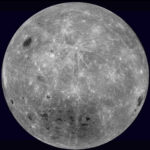- Series:Archaeology, Transcript English
Genesis 1:16
“And God made two great lights; the greater light to rule the day, and the lesser light to rule the night: he made the stars also.”
 The Moon is covered with craters. Other bodies in the Solar System are also covered with craters. If you look at an unlabeled photograph of Mercury, it is likely that you would simply assume it was the Moon because the cratering is so similar. Such craters have only been discovered since the advent of spacecraft to view the planets up close, so it was not until 1965, when the Mariner 4 craft flew by Mars, that craters other than on Earth or Moon were seen. Today, we know that a great many of the planets and moons of the Solar System are covered with craters which have been formed by the impact of bodies, such as meteors.
The Moon is covered with craters. Other bodies in the Solar System are also covered with craters. If you look at an unlabeled photograph of Mercury, it is likely that you would simply assume it was the Moon because the cratering is so similar. Such craters have only been discovered since the advent of spacecraft to view the planets up close, so it was not until 1965, when the Mariner 4 craft flew by Mars, that craters other than on Earth or Moon were seen. Today, we know that a great many of the planets and moons of the Solar System are covered with craters which have been formed by the impact of bodies, such as meteors.
This large number of craters represents a puzzle for all interested scientists. After all, cratering is not observed happening today. So, evolutionary astronomers suggest that there are particular periods when impact cratering has occurred. Most impact cratering is attributed to a period known as the Late Heavy Bombardment, or LHB, which they date at about 3.9 billion years ago.
Creationists also have models to explain the large amount of cratering. There are two main creationist models. Some suggest that the cratering was part of God’s formation of the Solar System on the 4th day of the Creation Week, while others suggest that cratering occurred in the early stages of the Flood and might have been a mechanism that triggered the Flood. In either case, the specific timetable given by creationist models seem to provide a much more satisfactory explanation of the phenomenon than a naturalistic model. Author: Paul F. Taylor
Prayer: We read that the heavens are telling of the glory of God, and as we learn more about even our Solar System, we are led to praise Your Name, O Lord, for all Your greatness. Amen.
Ref: Faulkner, D., Interpreting Craters in Terms of the Day Four Cratering Hypothesis, Answers Research Journal, 7 (2014):11–25, < www.answersingenesis.org/arj/v7/craters-day-four.pdf >, accessed 3/27/2018. Image: Far Side of the Moon, Public Domain (NASA).
